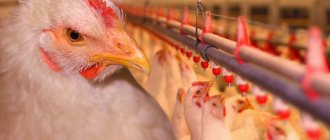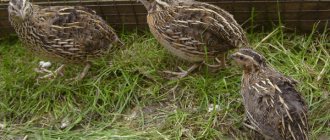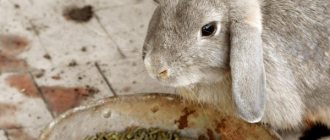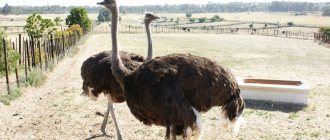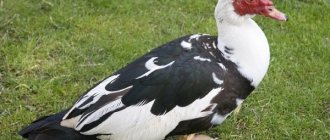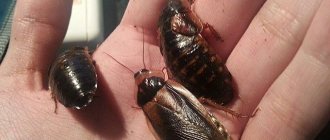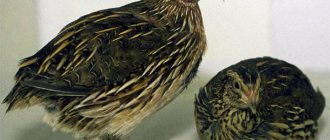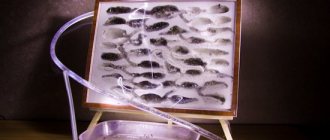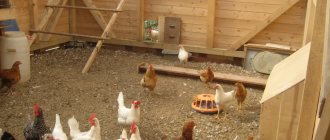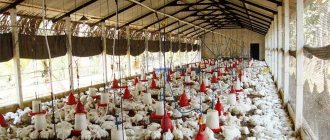Rabbit breeding is a promising area of business activity, especially now when agriculture and livestock farming in Russia are developing dynamically. Rabbit meat has advantages over traditional beef and pork. The market is open to new participants – the niche is almost empty.
When starting a business, an entrepreneur will have to take into account many nuances - only then can he gain a foothold in the market and develop sustainably. This article provides a business plan for “rabbit breeding” with calculations that will help you understand the aspects of the matter.
1. Market situation 2. The value of rabbit meat 3. How to run a business: private subsidiary or individual entrepreneur? 4. The best breeds of rabbits for breeding 5. Basic expenses for opening a farm 6. Complex of buildings 7. Sheds 8. Feed shop and warehouses 9. Slaughterhouse, freezers and manure collector 10. Breeding rabbits and feeding 11. Personnel 12. Sales of products 13. What Is the business profitable? 14. Step-by-step plan for starting a business 15. Main business risks
Market situation
The meat market in Russia shows mixed dynamics. This is due to turbulence in the global economy and corresponding processes in the Russian market. The increase in production volumes continues: in total, in 2022, 4.8% more products were produced than in 2016 (10.2 million tons).
The rabbit meat market has seen a trend toward a steady increase in production since 2014. The volume of consumption in 2016 amounted to 5.7 thousand tons (49% more than the previous year). In 2022, consumption fell by 1% to 5.6 thousand tons, but this is not explained by a loss of interest in rabbit meat, but by a general decrease in the purchasing power of the population.
The share of domestic products is 72%. More than 2/3 of total production comes from private household plots and small farms. In 2022, this meat was most consumed in the Central, Volga and Siberian districts.
Where to sell?
Let's now talk about selling the resulting products. Its directions should be considered based on the volumes of the future economy. If they are small (about 500 rabbits annually), the meat can be sold for sale or sold independently, subjected to a sanitary and epidemiological inspection.
For large farm volumes, you will need to obtain some additional documents. We are talking about a farm certificate, the same phytosanitary one, and a GOST-R declaration. If you complete all of the above, at the same time as trading at the market, you will have the opportunity to sell meat to a network of supermarkets and grocery stores.
The value of rabbit meat
Rabbit meat has advantages over its analogues that ensure competitiveness - especially if they are skillfully used during promotion:
- Great taste. There are many delicacies made from rabbit meat in the culinary world.
- Increased protein, low cholesterol. Absorbed by 90%, improves metabolism.
- The product is considered dietary. It contains very small amounts of sodium salts.
- The meat contains all amino acids, vitamins and minerals (C, PP, B12, B6, phosphorus, iron, calcium, manganese).
- It contains lecithin, which is useful for the prevention of atherosclerosis.
Rabbit meat helps strengthen bones, normalize blood sugar levels, and comprehensively strengthen the body.
Procurement of feed
Rabbits are finicky animals when it comes to food. For feeding you will have to use a complex of substances. It includes: feed, fruits and vegetables, hay and grains, as well as nutritional supplements of vitamins and minerals.
The daily norm for an adult rabbit is 100 g of feed . If you use a mixed type of feeding, then the feed rate is halved. The fertility of your rabbits will depend on a properly formulated diet, because as we know, obesity reduces their fruitful activity.
Feed is one of the main expenses, so many farmers want to reduce it. Considering that purchased feed is quite expensive, you can make it yourself. To do this you will need grain, grain waste, a grain crusher and a granulator. The concentrate feed has three different recipes, as separate feeds for adult rabbits and young animals, as well as for rabbits of all ages.
How to run a business: private subsidiary or individual entrepreneur?
First you need to choose the form that the rabbit breeding business will take. There are 2 options - personal subsidiary plot (LPH) and individual entrepreneur (IP). Each option has its own characteristics.
Private farming is suitable for those who intend to produce rabbit meat for further sale to friends or at agricultural fairs. An entrepreneur is exempt from paying taxes. Setting up a subsidiary farm is simple: just settle the issues with the local administration (village council), obtain a health certificate and a veterinary service report on the safety of meat.
Business in form provides opportunities for selling rabbits in retail stores and shopping centers. Based on the results of his activities, the businessman will pay tax to the budget. You will need to obtain certificates from the rabbit farm and phytosanitary service, confirm compliance with GOST and be accountable to Rosselkhoznadzor.
Taxation
If you plan to raise rabbits for the purpose of selling meat and fur, and not just to feed the family, the farm will have to be registered with the tax service.
Rabbit farming is work in the field of agriculture, which means that the most favorable tax payment regime will be the Unified Agricultural Tax.
Unified Agricultural Tax replaces personal income tax, property tax and VAT for individual entrepreneurs and income, property and value added tax for LLCs. The rate is only 6%, while the tax base can be reduced by the full amount of production costs. There are only two payments per year - an advance payment at the end of the half-year (in July) and a final payment at the end of the year (in March).
The best rabbit breeds for breeding
There are several types of rabbits that are suitable for a home mini-farm.
- New Zealand breed:
- Red. Individuals grow quickly, especially at an early age. Adults weigh about 5 kg.
- White. Rabbits also gain weight and fleshiness quickly. After only 3 months they reach a weight of 3-3.5 kg.
- California rabbit. Animals provide a lot of meat. During the first 2 months they increase by 45 grams. meat daily, after 5 months they weigh about 4.5 kg.
You should not buy downy and meat-skinned breeds - they are intended for other purposes and grow more slowly. When purchasing, carefully study the suppliers’ documentation, the characteristics of the breed, and evaluate the animals. The best place to buy rabbits is at agricultural shows.
Acquisition of the younger generation
The first step (after building or acquiring a farm) in the development of a rabbit farm is the purchase of young stock. Before purchasing pets, you need to decide on the breeding goals:
- Obtaining skins;
- Receiving meat;
- Dressing of hides and meat.
The direction of cultivation affects the characteristics of care, equipment, feed, and investments.
Raising rabbits for meat involves choosing specially bred breeds: gray and white giants, silver rabbits, chinchillas. Meat breeds quickly gain weight (up to 2 kg in 2 months).
In the skin direction, when selecting a breed, they focus on the quality of the fur. The most expensive fur coats are obtained by breeding Alaskan, Thuringian and fiery black rabbits. These breeds are quite rare, but the most valuable. Keeping rabbits of the skin type is quite expensive and not always profitable. Representatives of breeds with valuable fur require careful care, compliance with feeding standards in order to maintain the quality of the fur coat, and maintenance in separate enclosures. When dressing skins, a carcass remains, the quality of which is not suitable for sale.
There is a purebred method of breeding rodents. In this case, representatives of the same breed are purchased in order to increase the quality of products and enhance the valuable qualities of young individuals.
To multiply investments and run a profitable business, breeding rabbits must be thought out in advance. Recommended meat and skin breeds. Rapid weight gain, high-quality fur and ease of care create favorable conditions for the development of entrepreneurship. Starting with a small number of individuals, the most suitable breed is selected experimentally.
To start production, a pair of adult rodents is purchased. Females of the meat and meat-skin production produce fairly large offspring, which helps business development. When choosing a rabbit, pay attention to the appearance and health status of the rodents. Contact of sick individuals with healthy ones is unacceptable; it can lead to death.
Basic expenses for starting a farm
A business project for raising rabbits involves creating a livestock of up to 1000 individuals and developing a plot of land to support the life of the animals.
Table 1. Basic costs for breeding rabbits.
| Article title | Cost, rub. |
| Paperwork | 5 thousand |
| Land plot for rent, 1000 sq. m | 2 thousand |
| Construction of buildings and pits | 100 thousand |
| Construction of sheds, 3 pcs. | 70 thousand |
| Purchase of cells, 60 pcs. | 100 thousand |
| Purchase of rabbits, 60 individuals | 30 thousand |
| Feed, for a year | 120 thousand |
| Feeders, drinking bowls, slaughterhouse equipment, etc. | 50 thousand |
| Refrigeration and oven equipment | 70 thousand |
| Salary | 40 thousand |
| Additional expenses | 100 thousand |
| Total | 700 thousand |
Complex of buildings
The farm requires the purchase or lease of a country plot of land in accordance with accepted sanitary and environmental standards:
- no closer than 5 km from cities and industrial production;
- no closer than 2 km to rivers and reservoirs.
According to the terms of our business plan, about 1000 sq. m. will be required. m of area for 800-1000 individuals.
Table 2. Farm plan.
| Name | Area, sq. m |
| Sheds, 3 pcs. | 400 |
| Feed shop with entrances | 250 |
| Inventory storage warehouses | 100 |
| Slaughterhouse, freezing zone | 70-100 |
| Waste collection pit (manure collector) | 30-50 |
All buildings must be interconnected by passages and driveways, including for large equipment (trucks, tractors).
Remember that high humidity is unacceptable for rabbits. Therefore, it is better to build a farm on a hill.
Sheds
The shed system for keeping rabbits is considered optimal. It facilitates maintenance and allows you to use space with maximum efficiency.
Cages for storing animals are placed inside the shads, measuring at least 1 m in length, 0.5 m in height, 1 m in depth. Most often they are made from galvanized welded mesh with cells of a suitable diameter.
The cages are divided into 2 compartments - for the growth of the individual and its feeding. Feeders and drinking bowls are also installed inside. Indoors, the cages are placed in several rows. The lower one is located at a height of at least 60 cm from the floor.
The shed itself measures 20 m long, 2.2 m wide, 2.4 m high. It holds 60-70 cells.
The premises should be well insulated, provided with lighting and ventilation.
Feed shop and warehouses
Supplies of food for rabbits are stored here - compound feed, grain, hay - which should be enough for at least 2 months in advance. The rabbit must eat on time to grow, so it is recommended to replenish supplies in a timely manner.
In the room it is necessary to provide the conditions necessary for storing feed: hydro- and thermally insulate, maintain a stable temperature, prevent the appearance of rodents, mold, and the development of pathogenic bacteria.
In the feed shop you can install equipment for the production of compound feed. It will reduce your monthly food purchase costs.
Spare feeders, drinkers, building materials and other equipment should be stored in an appropriate room and always available - so that the problem can be eliminated as quickly as possible.
Slaughterhouse, freezers and manure collector
The slaughter and cutting of rabbits is carried out in a special place, which must be equipped with a blood supply and an oven for the destruction of offal. We are talking about illiquid skins, entrails, heads, paws.
The meat is packaged and sent to the freezer. Refrigeration equipment is placed nearby in which products ready for sale will be stored. This arrangement will allow for an uninterrupted production process.
The manure collector is a 3 m deep hole dug in the ground. It should be located at a distance from other premises. The walls should be concrete; it is recommended to make a canopy on top so that moisture can get inside.
Architectural and construction solution for the rabbit farm building
In the main production room there are cages for mother rabbits and offspring. The cages are installed on concrete bases that form manure removal baths. The building has four rows of 11 modular cages, each cage is designed for 12 equipped nests for mother rabbits and another 6 in the upper part for the repair department. After removing the nests, the cages are used for raising and fattening the rabbits. Next is a room for automatic feed distribution and watering installations, as well as for air intake and preheating. The farm building is a rectangular building measuring 12x33m, with a platform measuring 8x12m for loading manure through a manure removal ramp, as well as installing tanks or septic tanks for the liquid fraction . The building is divided into two parts by a partition in accordance with the empty-occupied ideology.
The manure removal system consists of open concrete tanks and a belt manure removal system. A tape made of polymer non-woven material is placed in the pits; as it is filled (but at least once every two weeks), it is necessary to pull the tape out using a tape reeler or a car to clean the channel. The liquid fraction flows down the slope and is discharged into a septic tank located next to the building; the septic tank is emptied as it fills.
In a forced ventilation system, air exchange is carried out due to the action of adjacent fans located at the ends of the building; the principle of exhaust ventilation is used. Their advantage is the ability to finely regulate the air exchange power, regardless of external climatic conditions. The exact number of fans is determined by calculation.
Rabbit breeding and feeding
Females are capable of mating up to 4 times a year. One female rabbit gives birth to 6 to 8 rabbits. The suckling period takes at least 60 days.
From the livestock, breeding female rabbits and breeding males are distinguished. They are placed in separate cages on the middle tier of the shad. If there are 15 females in it, they will be able to give birth to more than 360 rabbits in a year. In 3 shad there are more than 1000 individuals.
Rapid reproduction is also possible with proper feeding of animals. It is considered optimal to use feed that provides maximum nutritional value. It is also necessary to give vitamin and mineral supplements, high-quality hay, and well-cured grass.
Proper feeding of rabbits is a whole science. The materials on this case need to be studied separately.
Reproduction
Rabbits are such prolific animals that they reproduce well even without human intervention. All that is required in a farm environment is to monitor the health of animals, as well as timely breeding and breeding of animals.
The optimal weight for a female to begin mating is approximately 2.5 kg, for a male - from 2.5 to 3 kg. They should be healthy, neither fat nor thin. At one time, a male can fertilize up to 8 females. Animals ready for mating are brought together in one cage, after removing all foreign objects from there. The process will take several minutes: first a short mating game, then a 30-second mating.
Pregnancy in female rabbits lasts from 27 to 30 days. At this time, it is especially important for females to provide peace and quiet, to isolate them from other animals. Childbirth is almost always successful without human assistance. After giving birth, the rabbit is not touched for 1-2 days, then the cage is cleaned and the number of newborns is checked.
Rabbits have problems with maternal instinct. Some do not feed their offspring, and some even eat the young. To prevent this from happening, you need to monitor the behavior of animals and separate them from unhealthy behavior.
Many cages will be required as animals need to be separated from each other
Staff
A rabbit breeding farm requires the constant work of an entire production team:
- Operator worker, 1 person. They are engaged in servicing the rabbit population, monitoring the vital activity and health of individuals.
- Worker for slaughtering rabbits and packing meat, 1 person. Kills animals (possibly using electric current), cuts up products, packages them, packs them, puts them in refrigerators. The remaining 2 positions can be outsourced.
- Veterinarian. Manages the organization and implementation of all sanitary and veterinary measures, advises workers.
- Engineer. Monitors the serviceability of equipment and carries out repairs.
You may also need the services of an electrician, a cleaner, an accountant, or a driver for delivering meat.
Useful tips for beginners
It is useful for novice rabbit farmers to study the recommendations of experienced breeders.
Professionals advise following the following instructions:
- Outdoor pens must have canopies.
- Make wooden slatted floors in cages, wrapping them with metal profiles.
- It is better to choose a design that allows you to give food and pour water into the drinking bowls without opening the door.
- Rabbits should be fed hay year-round.
- Protein in the diet should be 14–20%. Average indicators (16%) contain mixed feed.
- Be sure to vaccinate your rabbits.
- To keep the meat clean, animals need to be fed hay, root vegetables and vegetables.
- After giving birth, the female and her offspring need to be given a lot of attention.
Breeding rabbits on a mini-farm is a promising and profitable type of business. With proper organization and arrangement, the breeder can expect offspring with minimal mortality and good growth of adults, the carcasses and fur of which will bring financial profit.
Sales of products
Industrial production of rabbit meat in Russia is still at the formation stage. However, the demand for meat is high and remains largely unsatisfied. Experts predict an increase in rabbit meat consumption by approximately 1-2% per year.
The manufacturer has several sales channels for the product.
Firstly, forming your own client base. We are talking about the farmer’s own acquaintances, his family’s acquaintances, and so on. Word of mouth is important, especially if you offer meat inexpensively.
You also need to place advertisements in newspapers and on the street. This way an entrepreneur can create his own base of regular customers.
The second channel is sales through stores. We are talking about retail stores and small chains. You can sell meat to restaurants.
Is it profitable to breed eared animals?
Before starting to draw up a business plan, farmers find out whether it is profitable to breed rabbits, what costs the enterprise incurs, what cost items exist when planning and implementing a business plan.
Raising rabbits is beneficial because:
- There is not enough quality rabbit meat on the market to cover demand.
- Dietary rabbit meat is more popular than other low-calorie meat products.
- The cost of the product is set by the manufacturer.
- High profitability.
When creating an enterprise, large investments are required - this is one of the disadvantages of a rabbit farm.
Rabbit meat is considered a delicate dietary product, rich in essential vitamins, minerals, and nutrients. The product is undoubtedly useful for humans, so the demand for rabbit meat is increasing. To generate income, the quality and volume of meat must meet consumer demand.
Dressing hides is considered a less profitable business, but valuable fur is used. Growing the skin type is somewhat more difficult, since constant monitoring of the condition of the wool is required. The meat of these animals is unsuitable for sale, so the profitability of such an enterprise is low.
What is the profitability of the business?
Our business plan for rabbits assumes the cost of opening a small farm is about 700 thousand rubles. Let's calculate income from activities.
The total is: 1000 individuals, subject to regular slaughter, population renewal, and growth of young animals, can produce up to 4 tons of meat per year. The average price of 1 kg is 300 rubles. Annual revenue - 1.2 million rubles. Annual expenses – salary, utilities, feed. It turns out to be approximately 800 thousand rubles. Net profit – 400 thousand rubles.
Thus, the rabbit breeding business will pay for itself in about 2 years, then it will begin to generate a stable income.
Wages for hired workers in rural areas are low, especially since the work requires only a few hours a day. Renting state land is much cheaper than buying it.
Here we do not take into account the profit from the sale of skins - this is more than a hundred thousand rubles a year.
Additional sources of income
A good option to increase benefits for rabbit breeders is the sale of secondary products - skins and droppings.
Rabbit skins
Everyone knows that in addition to healthy meat, rabbits produce skins of the finest quality. Fur products made from rabbit are very popular and in demand in our market. In some regions, winters are quite cold, and a rabbit hat or fur coat will always protect you from the frost. And the cost of such clothes is several times cheaper than those made from the fur of other animals. Therefore, there will always be a buyer for the skins. Despite their low price, this is additional income.
Litter
Nowadays, we have begun to value natural organic products, in other words, those grown without the use of chemical fertilizers. But for normal growth and high yields, plants are still fertilized. For example, the same rabbit manure. You won’t be able to earn much from selling manure due to the small volumes, but you will get your contribution to the total income. In addition, it is possible to organize the production of vermicompost (concentrated liquid fertilizer obtained by fermenting manure), which is very much appreciated among farmers. You can get significantly more income from vermicompost.
Step-by-step plan for starting a business
- Choose a form of activity - private household plot or individual entrepreneur - depending on your plans for selling products.
- Buy a plot of land (or rent it). If you already have one, you need to make sure that it meets the legal requirements for creating a mini-farm.
- Build a building system.
- Erect sheds, install cages in them, create suitable conditions for rabbits in the cold and warm seasons.
- Create a room for compound feed. You can use existing buildings, but you will need to make repairs.
- Designate a room for slaughtering, storage of refrigeration equipment and a warehouse.
- Dig and arrange a manure pit.
- Hire workers.
- Buy feed, prepare supplies.
- Get a population of rabbits and start breeding them.
- Develop a marketing plan.
Cutting shop
The time for slaughtering rabbits comes very quickly due to the extraordinary precocity of these animals. You should prepare for this moment in advance by equipping a workshop where the slaughter and cutting of rabbits will take place. Mini-slaughterhouses for these animals are available for sale. They meet all the necessary requirements of existing standards and have a certification document.
They have the possibility of expanding the line with an increase in the number of animals. When fully loaded, there is a quick payback. If you want to start a rabbit business, you should take care of this equipment in advance, and include the costs in your business plan.
Main business risks
When opening a mini rabbit farm, you need to take into account the risks.
The main risk is high animal mortality. The main danger comes from various viruses and pathogens, leading to mass death of the population. Dangerous diseases are hemorrhagic fever and myxomatosis. The mortality rate from them reaches 90%. The problem of diseases is solved through vaccinations.
The next danger is improper feeding. Rabbits do not know when to stop and can eat too much food that their weak digestive system cannot handle. To avoid rabbits dying from bloating, approach the issue of feeding wisely.
After mowing, the grass should be left to dry and dry for a day. This will allow you to get rid of substances that are toxic to the animal’s body.
A business plan for selling rabbits will help a novice entrepreneur assess the prospects, advantages and risks of this business, as well as calculate approximate profit margins.
Skin dressing
No one can kill a rabbit the first time and get a whole beautiful skin. This must be learned and preferably from the old and sick, from whom it is impossible to benefit.
In theory, the process is simple: after the blood has drained from the carcass, cuts are made on the joints of the hind legs and the skin is pulled off. But this must be done carefully, without stretching, otherwise the fur will deteriorate and tears will appear.
After removing the skin, the following manipulations are carried out:
- Soaking it in water at room temperature with added salt. If possible, experts recommend pressing them down.
- Cleansing of fat, muscles and ligaments. It is put on the nozzle and the excess is scraped out with a knife. It is important to choose a small base to prevent stretching.
- Pickling - processing in a solution with acids.
- To consolidate the result and protect the skin from water, it is tanned: rubbed with willow decoction from the inside.
- Fatting is rubbing the skin with a solution of laundry soap and animal fat. This gives elasticity and softness to the fur.
After this, everything is dried, combed and delivered to the customer. To maintain quality, you cannot skip any of the stages and follow the technology.
Along with paws, tails, and ears, by-products include skins that have not passed certification. During the dressing process, most of them are damaged and they cannot be sold at a favorable price. But this is not a reason to throw them away. The following materials are created from spoiled skins:
- different types of leather: chrome, velor, suede or lycra;
- lining for outerwear;
- creating imitation crocodile skin for accessories;
- felt for felt boots and hats.
Other by-products such as paws, tails and ears are used to create souvenirs and keychains.
